
- Index
- Artist
- Antonio Devity (4)
- Charles Levier (3)
- Henri Matisse (7)
- Illegible (5)
- Illegible Signature (58)
- Jean Daumier (3)
- Julius Polek (3)
- L. Sihiinzel (4)
- London (4)
- Maren (3)
- Max Ernst (6)
- Reinald Morgen (3)
- Remedios Varo (7)
- Salvador Dali (6)
- See Description (9)
- T.bailey (4)
- Unknown (109)
- Unsigned (7)
- Yu Liang Jin (4)
- Yu Yin Xin (4)
- Other (919)
- Framing
- Material
- Size
- Theme
- Type
ANTIQUE PLEIN AIR LANDSCAPE RIVER IMPRESSIONIST OIL PAINTING OLD VINTAGE 1960s
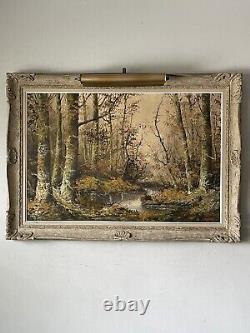
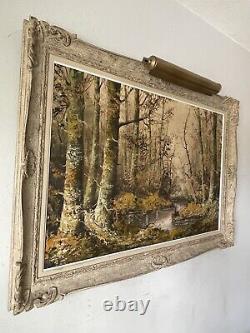
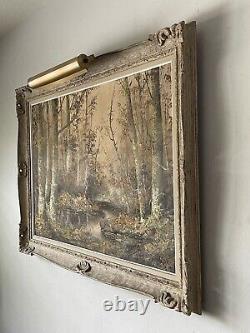
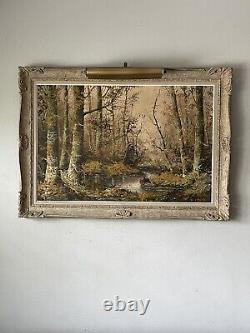
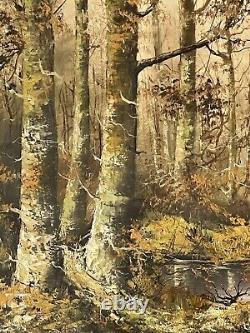
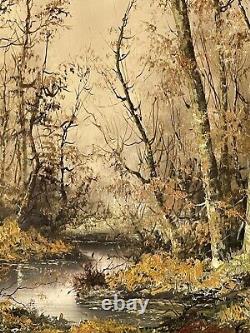
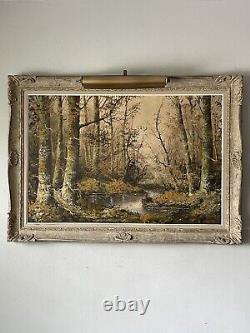

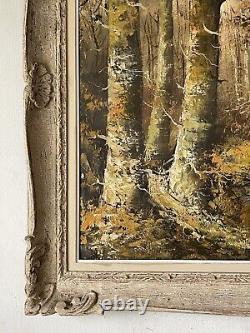
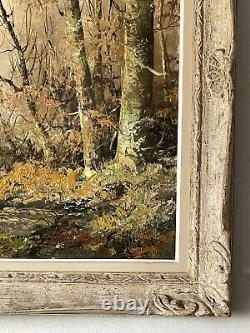
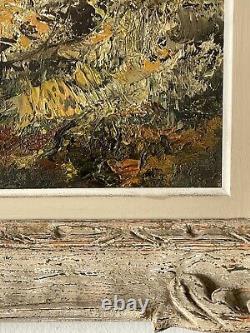
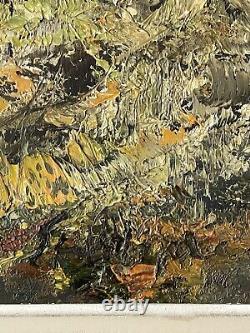
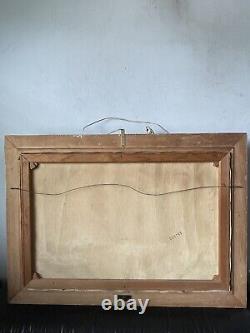
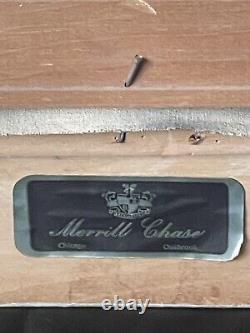


BEAUTIFUL AND CAPTIVATING ANTIQUE PLEIN AIR LANDSCAPE IMPRESSIONIST OIL PAINTING ON CANVAS DEPICTING A HARMONIOUS BLEND OF SCULPTED TREES AND GOLDEN EARTH TONE FOLIAGE DIVIDED BY A CALM MEANDERING RIVER. LIGHTING PLAYS AN ESSENTIAL ROLE IN THIS PAINTING, WITH THE ARTIST USING THE INTERPLAY OF LIGHT AND SHADOW TO ENHANCE THE OVERALL ATMOSPHERE INVITING THE VIEWER INTO A SERENE, PICTURESQUE NATURAL SETTING. THIS WORK IS SIGNED IN THE LOWER RIGHTHAND CORNER. HOWEVER, THE SIGNATURE IS ILLEGIBLE. PERHAPS YOU RECOGNIZE THE ARTIST?
IT DATES AROUND THE 1960s. IT HAS AN OLD MERRILL CHASE CHICAGO GALLERIES LABEL ON THE REAR. DIMENSIONS: 30"H x 42"W. Merrill Chase Galleries was an art dealership in Chicago, Illinois. It was started in 1964 by Robert Merrill Chase Sr.
And his father, Merrill Chase. By 1978 it had more than 150 employees and 13 galleries and was among the largest organizations of its kind in the United States. In the early 1960s, Bob Chase began developing a plan for a fine art gallery. He had recently graduated from the University of Wisconsin-Madison and convinced his father, Merrill Chase, who owned a portrait photography business, to join him in opening a fine art gallery that would focus on emerging artists, mid-career artists, and works of art on paper by masters.
Bob also wanted to be among the first fine art galleries in the suburbs. According to Bob Chase, We were pioneers, mavericks.
People were moving to the suburbs and building homes. We were at the birth of that movement. The first Merrill Chase gallery opened in 1964 as a combined art gallery and photo studio located in a new suburban mall called Oakbrook Terrace (later Oakbrook Center) in Oak Brook, Illinois. Oakbrook Terrace was then the second largest mall in the United States, and featured an open-air format, elegant gardens, boutique shops and upscale department stores.
This was a departure from the manner in which traditional fine art galleries operated in Chicago. Many were downtown appointment-only showrooms that catered to people of means. As Chase explained, Galleries were designed for the privileged few - and the idea of going into a gallery was frightening to people.
You'd walk in and feel like whispering. Our idea was to offer good art in various price ranges and somehow find a way of making it more accessible. The first Merrill Chase gallery was opened with a modest investment.
With some additional capital, Chase bought a few works on paper by Dali and Picasso, borrowed pieces and opened the doors with a modest inventory. The gallery business took off and the company formally became Merrill Chase Galleries Ltd in 1965, with Bob Chase as president and Merrill Chase as honorary chairman of the board. Thirteen years later, in 1978, Merrill Chase Galleries had 13 locations with over 150 staff members. From 1969 through 1988, Merrill Chase Galleries added suburban locations and locations in Chicago: opening in River Oaks Center, Calumet City, Illinois in 1969; Old Orchard Shopping Center (now Westfield Old Orchard), Skokie, Illinois, in 1970; Hawthorn Center (now Hawthorn Mall), Vernon Hills, Illinois, in 1975; Westfield Fox Valley (now Fox Valley Mall) in Aurora, Illinois, in 1975; Water Tower Place, Chicago, in 1976; Woodfield Mall, Schaumburg, Illinois, in 1977 Orland Square, Orland Park, Illinois, in 1978 the Merchandise Mart, Chicago, in 1980 and First National Bank Plaza, (now Chase Tower), Chicago, in 1982. The business also expanded nationally, with locations in the Fashion Show Mall, in 1980, in Las Vegas; in Atlanta, Georgia in 1989; Georgetown, Washington D.In addition, the company opened art boutiques in Chicago: The ARTique and Gallery Moya in 1984 and Gallery Lara in 1988. Corporate offices were in Northbrook, Illinois, opening in 1980.
Influencing the fine art business. As one of the largest fine art dealers in the country from the mid-1970s to the late 1980s. The business approach was based on connecting the artist's passion to create; the collector's passion to acquire; and the dealer's passion to promote and support both. The three elements of this artistic passion were influenced by noted art dealers Leo Castelli and Ambroise Vollard, and collectors including Iris Cantor and B. Gerald Cantor and Roy Neuberger. According to Bob Chase, careful attention was required to keep the interests of artist, dealer and collector in balance. Neuberger described the role of the gallery owner as extremely important to the careers of artists they represented. We might have known nothing about the greatest artists of our time had they not had dealers who believed in them and worked tirelessly to see that they reached the audience they deserved.It's not that studied; it's more intuitive. When I see something that I think is right, it's like a bell going off. According to Bob Chase, If we believe in an artist strongly enough to represent him in our galleries, we should make a total commitment to that person. Purchasing the art upfront was beneficial for the artist or dealer, the gallery, and the consumer: artists received immediate revenue, and for that reason they would often reserve their best works at their best prices for Merrill Chase Galleries, thus allowing the galleries to offer customers a wide selection at favorable prices.
In 1979, the business acquired a complete set of Pablo Picasso's "Vollard Suite, " 100 etchings created from 1930 to 1937. More than 300 sets of the Vollard Suite were printed.
Merrill Chase Galleries was among the first to announce exhibitions through large display and full-page advertisements in newspapers, was the first to place full-page advertisements in national magazines, such as TIME and Playboy, and the first to conduct major radio and television campaigns. The newsletter showcased articles about popular artists at the gallery and provided prices of their work along with photos from recent auctions and events. The company published a brochure, The Story of Prints, explaining the terminology of fine prints and describing printmaking techniques. Merrill Chase Galleries also offered printmaking demonstrations, provided tours for schoolchildren, and supported public service projects such as lectures to nonprofit groups and auctions for charitable organizations. In 1969, Salvador Dalí and Merrill Chase Galleries began a collaboration following meetings with Bob Chase.
The artist took a liking to Bob and dubbed him Mr. Chicago, a nickname that stuck throughout their collaborative years. In 1970, Dalí was commissioned by Merrill Chase Galleries to create four drypoint etchings, collectively entitled "Visions of Chicago"[49] The suite was composed of personal interpretations by Dali of four Chicago landmarks that defined the city and its spirit: Buckingham Fountain, the Art Institute of Chicago, the Museum of Science & Industry and the Chicago Water Tower. The complete set of the "Visions of Chicago" is in the collection of the Art Institute of Chicago, a gift of Merrill Chase Gallieries. In the early 1970s, being aware of Dalí's interests in and admiration for Leonardo da Vinci and his conceptual scientific and futuristic thinking, Bob Chase suggested to Dali it was time to give the world Dalí's own vision of things to come.In response, Dalí proclaimed, Bravo! Dalí will create the future. The deal involved a commission for Dalí to create 10 original paintings and a suite of 10 mixed media graphics entitled Imaginations and Objects of The Future.
At a press conference on March 6, 1975, Dalí unveiled one of his 10 "Imaginations and Objects of the Future a painting titled, "Spectacles with Holograms and Computers for Seeing Imagined Objects. Bob Chase of Merrill Chase Galleries was the primary publisher of Frederick Hart's work in sculpture from 1980 until Hart's death in 1999 at the age of 55. The association began when Bob Chase read about Hart in an art journal, Horizon Magazine, [60] which featured a clay model for Hart's "Ex Nihilo" (Out of Nothing) for the center tympanum of The Creation Sculptures ensemble on the west facade of Washington National Cathedral. Bob Chase sought a meeting with Hart and the two men became longtime friends[53] and collaborators and Merrill Chase Galleries became one of Frederick Hart's most important dealers.
